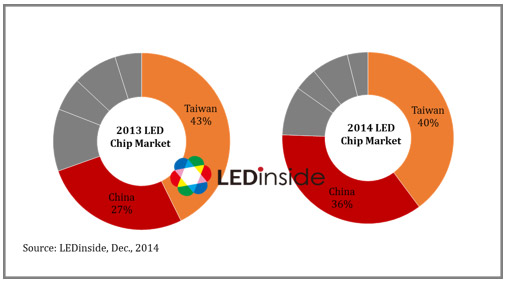- News
23 December 2014
LED makers to raise technology entry level and find new applications to boost profitability in 2015
For many LED makers, 2014 has been a challenging year, with performance in the first and second halves of the year very polarized for many, notes Roger Chu, research director of LEDinside (a research division of TrendForce). Lighting market demand was stronger than expected in first-half 2014, leading to a period of LED supply shortages, he adds.
Despite the positive development, the industry was impacted by clients double booking plus distributors rising inventory levels during second-half 2014. Many manufacturers were impacted by the market’s cooling demand, and consequently price competition. Also, the emergence of Chinese LED makers has led to sliding LED product prices. Hence, LED makers will raise technology entry levels and find new applications in the hope of boosting profitability in 2015, expects Chu.
LEDinside highlights the top five industry trends to watch out for in 2015 as follows.
1. Market shares of Chinese LED makers grow; big manufacturers become even larger
LEDinside estimates that 239 new MOCVD systems were installed worldwide in 2014. Some local governments will continue to issue subsidies in China throughout 2015, so more than 170 new MOCVD systems are expected to be installed in China. Overall, LED makers’ expansion projects depend on local governments subsidies, hence LED chip manufacturers will grow.

Picture: Shares of global LED chip production for Taiwan and China in 2013 and 2014.
As Chinese LED chip makers improve their technology and scale up production capacity, China’s LED chip production has increased from 27% in 2013 to 36% of the global LED chip market in 2014. In the past, Chinese LED backlight and lighting applications have largely relied on Taiwanese or international LED manufacturing, but this is no longer the case. Due to Chinese package manufacturers increasing their usage of domestic LED chips, prices are becoming increasingly competitive, leading to Chinese manufacturers growing their market share in the global LED industry.
2. LED lighting clients continue to seek low-cost solutions
Spurred by falling product prices, great LED lighting market demand has emerged. LED bulbs remain the main growth drivers for LED lighting products in 2015, including LED bulbs, tubes and other light source products, says Chu. Therefore, LEDs retail price and costs are often the main factors taken into consideration.
Standard- and mid-power LEDs with a good C/P (cost-to-performance) ratio often meet these LED lighting products’ lower price demands - for example, 3030 and 2835 LEDs have become mainstream on the market. Future LED makers will continue to find better heat dissipation materials, and use high driving currents to reduce the number of LEDs, says Chu. Even chip-on-board (COB) LEDs have gradually attracted attention from lighting manufacturers. Besides lower LED prices, LED lighting manufacturers have also turned their focus to drivers and other components, in the hope of designing total solutions in order to reduce costs.
3. Finding special niche applications to raise profitability
Due to intense LED price competition, LED makers hope to find new applications to raise profitability. For example, invisible LED lights including ultraviolet (UV) or infrared (IR) LEDs are gradually becoming valued by LED makers. However, invisible LED lighting remains a niche market, and cannot compare with LED lighting or backlighting application volumes, says LEDinside. Due to technical difficulties, customized demand and close cooperation with system manufacturers, the market sector has a much higher entry level. Gross margin for invisible LED products is therefore markedly better than that for white LED.
4. Growing automotive LED market value; exterior automotive lighting market showing highest growth
The automotive LED market has grown steadily, with daylight running lamps (DRL) and high/low beam lights showing the most significant growth. This is mainly due to automotive LEDs - driven by advances in LED technology and the drop in LED prices - gradually shifting from high-end to mid-class models of car. This will spur automotive lighting demand over the next few years, reckons LEDinside. Additionally, car panels remain the largest LED backlight application in cars. Also, accompanying the spread of multimedia and image sensors, traditional panels have all been changed to LCD panels, spurring demand for automotive backlight.
5. Mobile phones become thinner; smart-phone backlight LED specs turn towards 0.4t
Many manufacturers are trying to upgrade backlight LED specs to counteract price competition. In the case of handheld devices, high-end smart-phones are becoming thinner, with increasingly higher panel resolutions. This challenges LED makers to make thinner and brighter LEDs in 2015. Currently, high-end smart-phones are using 0.4t LEDs as major backlight specs, with a brightness of 2500-2700mcd. In the 4.7” iPhone 6 smart-phone, 10-12 LEDs are used in the backlight modules, since 0.4t and 0.6t LEDs have become thinner, and are now the slimmest LEDs in the mass-production backlight market. On the other hand, package technology has a much higher technology entry level. Korean and Japanese LED makers, such as Nichia, have been the main suppliers for this technology. Furthermore, the 0.4t LED has been introduced into the iPhone 6 backlight, which will even shift towards the thinner 0.3t LED in the future.
As for TV LED backlight specs, raising LED brightness to satisfy the demands of 4K2K panels - and the introduction of the NTSC 100 high color gamut - will also become a development focus for LED makers, forecasts LEDinside. All in all, LED makers will have to figure out ways to upgrade the entry level to have an upper hand in the price war, the firm concludes.


